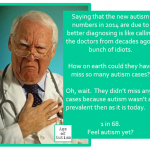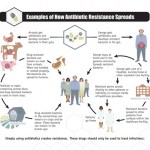CDC
Ideally, everyone should be tested for HIV and in fact, federal guidelines introduced in 2006 recommend routine HIV screening for all patients. In reality, however, only about half of U.S. adults have ever been tested for HIV and about half of the 50,000 new infections that happen every year in the U.S. are transmitted by people who are unaware of their HIV status. Such statistics recently led a group of researchers to ask if there’s a more efficient way to go about curbing the HIV epidemic.
“We strongly support the concept of universal testing and treatment to limit or control the spread of…
Five million dollars. That’s how much the fast food industry spends every day to peddle largely unhealthy foods to children. And because studies have found that exposure to food marketing does indeed make kids want to eat more, advertising is often tapped as an obvious way to address child obesity. Fortunately, a new study finds that the public agrees.
As part of the Los Angeles County Health Survey, researchers with the Los Angeles County Department of Public Health asked nearly 1,000 adults four food policy questions: would they support a tax increase on sodas to discourage kids from…
Researcher Christopher Wildeman has spent his whole career describing and quantifying the more unpleasant parts of people’s lives and his latest study on the surprising prevalence of childhood maltreatment is no exception. Still, there is a bit of a silver lining, he told me.
“This is the sort of issue that both the right and left shouldn’t have a hard time supporting,” said Wildeman, an assistant professor of sociology at Yale University. “It’s the sort of thing that once we become more aware of it, designing interventions that could diminish maltreatment rates is something anyone can get…
Where you live may be hazardous to your health. This is the conclusion of several recent reports and studies, among them a supplement to the most recent examination of health disparities by the US Centers for Disease Control and Prevention (CDC) and an analysis by the Environmental Justice and Health Alliance for Chemical Reform of those who live in communities most vulnerable to hazardous chemical exposures. Together the two paint a disturbing picture of how the neighborhoods in which Americans live and work play a significant role in determining their residents' health. There should be no…
Climbing the corporate ladder is usually associated with promotions, salary raises and executive offices. But for many workers, the common metaphor is part of a real-life job description with real-life risks.
Last week, the Centers for Disease Control and Prevention released new data on occupational ladder falls, finding that a fifth — or 20 percent — of all fall injuries among workers involve a ladder. Among construction workers, 81 percent of all fall injuries treated in an emergency department involved a ladder (overall, falls are a leading cause of death in construction). In 2011, CDC…
Bat Signal time!
Here's a quickie that I can't resist publicizing. Antivaccinationists appear to be planning on crashing the CDC's Twitter party for National Infant Immunization Week, which will take place at 1 PM EDT today. Here's our "friend" Ginger Taylor promoting the hashtag #CDCvax to her Twitter followers:
Learn About National Infant Immunization Week at the #CDCvax Twitter Party on Wed, Apr 30 @ 1pm. #CDCvax http://t.co/3ZBN1uYKxt
— Ginger Taylor (@GingerTaylor) April 30, 2014
The intent is clear. Ginger wants to flood the Twitter chat with antivaccine nonsense and conspiracy…
As I just mentioned a week ago, there used to be a time when I dreaded Autism Awareness Month, which begins tomorrow. The reason was simple. Several years ago to perhaps as recently as three years ago, I could always count on a flurry of stories about autism towards the end of March and the beginning of April about autism. That in and of itself isn't bad. Sometimes the stories were actually informative and useful. However, in variably there would be a flurry of truly aggravating stories in which the reporter, either through laziness, lack of ideas, or the desire to add some spice and…
It’s not the first study to examine the enormous health and economic benefits of vaccines. But it’s certainly another impressive reminder about the power — and value — of prevention.
In a study published online earlier this month in the journal Pediatrics, researchers found that childhood immunizations among babies born in 2009 will prevent 42,000 early deaths and 20 million cases of disease, saving the nation $13.5 billion in directs costs (medical costs and disease outbreak control) and more than $68 billion in total societal costs (premature death and lost productivity). That means that…
On January 9, 2014 a leak was reported at Freedom Industries’ storage tanks on the banks of the Elk River just upstream of a water treatment plant that services tap water for about 300,000 residents in and around Charleston, West Virginia. The resulting release of at least 10,000 gallons of toxic chemicals used to clean coal contaminated the community’s water supply, making it unfit for use. More than a month later, it remains unclear if this water is truly safe to drink and what the health consequences of exposure to these chemicals may be.
But this is far from the only disastrous toxic…
Most people infected with mosquito-borne West Nile virus don’t experience any symptoms at all. However, the tiny percentage of cases that do end up in the hospital total hundreds of millions of dollars in medical costs and lost productivity.
Published earlier this week in the American Journal of Tropical Medicine and Hygiene, researchers estimated that the cumulative cost of reported hospitalized cases of West Nile virus between 1999 and 2012 totaled $778 million. The study is the first to examine the economic burden of West Nile on infected patients who were hospitalized with conditions such…
Higher insurance rates don’t mean people stop seeking care at publically funded health centers, found a recent study of family planning clinics in Massachusetts. The findings speak to serious concerns within public health circles that policy-makers may point to higher insurance rates as a justification to cut critical public health funding.
Published in the Jan. 24 issue of Morbidity and Mortality Weekly Report, the study examines trends among uninsured patients seeking care at Massachusetts health centers that receive Title X Family Planning Program funds. (The federal Title X program…
At least 1.7 million US workers are exposed to respirable crystalline silica each year, this according to the National Institute for Occupational Safety and Health (NIOSH). These exposures occur in a variety of industries, among them construction, sandblasting, mining, masonry, stone and quarry work, and in the rapidly expanding method of oil and gas extraction known as hydraulic fracturing or fracking. This exposure can lead to silicosis, an irreversible, and sometimes fatal, lung disease that is only caused by inhaling respirable silica dust. Silica exposure also puts exposed…
by Anthony Robbins, MD, MPA
A recent editorial in the New York Times, "Rolling the dice on food-borne illnesses," focused on just one of the many health dangers related to the federal government shutdown. The editorial reminded me of developments in Vermont almost forty years ago, when I was the State Health Commissioner.
Vermont's House Appropriations Committee was threatening to cut the Health Department's budget. After telling the Committee members that they would be hurting the Department’s ability to protect the public, including from foodborne and waterborne illness, I…
Antibiotic-resistant infections kill 23,000 people in the US and sicken two million each year, and the problem is getting worse, warns a new report from the Centers for Disease Control and Prevention. Antibiotic Resistance Threats in the United States, 2013 ranks several strains of bacteria according to their current and projected health and economic impacts. It describes 18 microorganisms whose threat levels are "urgent," "serious," or "concerning."
CDC identifies three bacteria as urgent threats: Clostridium difficile, Carbapenem-resistant Enterobacteriaceae (CRE), and Drug-resistant…
For older workers, the most dangerous occupational move may be getting behind the wheel.
Last Friday, the Centers for Disease Control and Prevention released data showing that among highway transportation incidents, which are the leading cause of occupational death in the country, the highest fatality rates occur among workers ages 65 years old and older. In fact, workers in that age group experienced a fatality rate three times higher than workers ages 18 to 54. The unfortunate trend was seen across industries and occupations and among most demographic groups, according to data published in…
After years of hearing about alarming increases in states' obesity rates, it was nice to get some good news: CDC reports that the percentage of low-income preschool children classified as obese has declined in 19 states. (Height and weight data came from 11.6 million children aged 2-4 participating in the Pediatric Nutrition Surveillance System, which monitors the nutritional status of low-income children. Children whose body mass index was at or above the 95th percentile on CDC's growth charts were classified as obese.)
Improvements among obesity rates of school-aged children have been…
When I asked Teresa Schnorr why we should be worried about the loss of a little-known occupational health data gathering program, she quoted a popular saying in the field of surveillance: "What gets counted, gets done."
Schnorr, who serves as director of the Division of Surveillance, Hazard Evaluations and Field Studies at CDC's National Institute for Occupational Safety and Health (NIOSH), was referring to the Adult Blood Lead Epidemiology and Surveillance program (ABLES), a state-based effort that collects and analyzes data on adult lead exposure. For more than two decades, NIOSH has been…
Last year, reported cases of West Nile virus in the United States hit their highest levels in nearly a decade. It's a good reminder to keep protecting yourself from getting bitten, but it also begs the question: Is this just a sign of a much bigger threat? The answer is just as wily as the pesky mosquito.
According to recent data published June 28 in CDC's Morbidity and Mortality Weekly Report, the federal public health agency received reports of 5,780 nationally notifiable arboviral disease cases in 2012. (Arboviral diseases are those transmitted by arthropods, such as ticks and mosquitoes…
by Kim Krisberg
It seems we barely go a week now without news of another violent gun incident. Last week's shooting rampage in Santa Monica, Calif., has resulted in the deaths of five people. And since the Newtown school shooting last December — in the span of less than six months — thousands of Americans have been killed by guns.
Just a couple days before the Santa Monica shooting, the Institute of Medicine (IoM) and National Research Council released a new report proposing priority research areas for better understanding gun-related violence, its causes, health effects and possible…
by Kim Krisberg
On Feb. 13, 2012, Honey Stecken gave birth to her daughter Maren. Everything appeared perfectly fine — she ate and slept and did all the things a baby does. Even after a couple weeks at home in South Fork. Colo., with her newborn little girl, nothing seemed out of the ordinary.
About two weeks after Maren's arrival, while Honey was at a children's birthday party for one of her son's friends, she received a call from a doctor she didn't know. He was calling on a Saturday, never a good sign. With an urgent tone in his voice, he asked if Maren was eating well, if she was vomiting…

